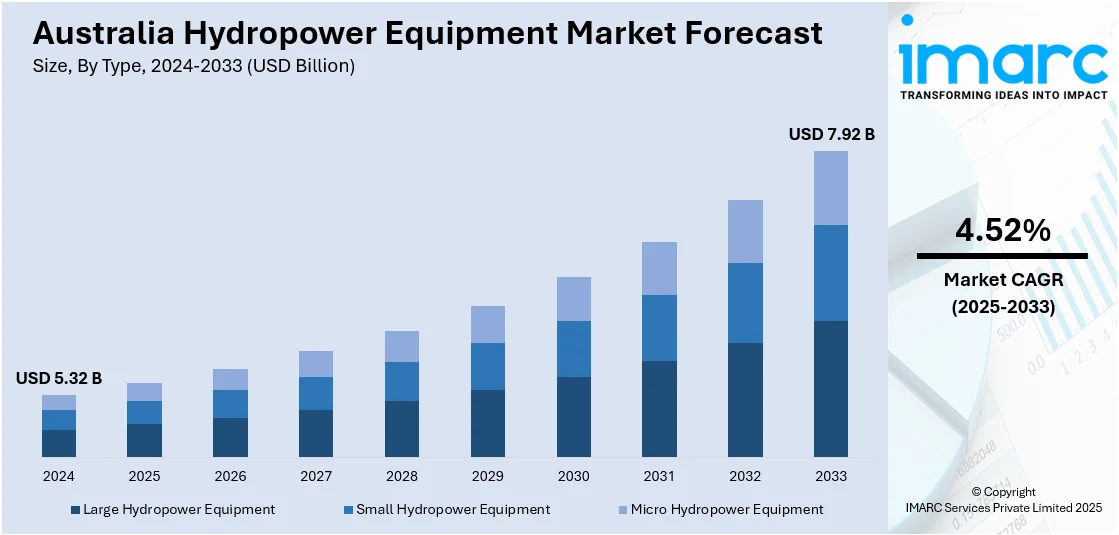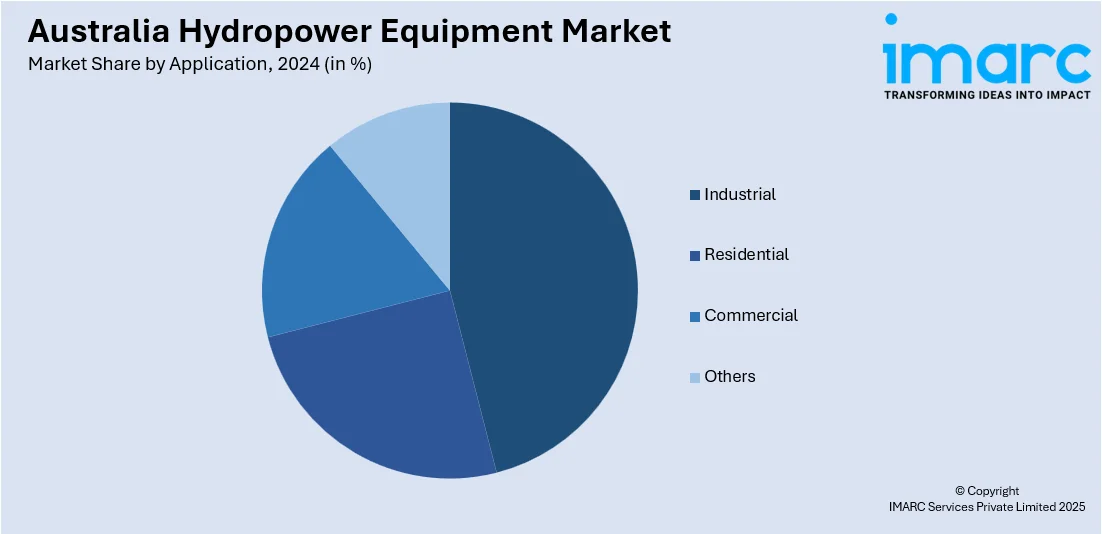
Australia Hydropower Equipment Market Size, Share, Trends and Forecast by Type, Application, and Region, 2025-2033
Australia Hydropower Equipment Market Overview:
The Australia hydropower equipment market size reached USD 5.32 Billion in 2024. Looking forward, IMARC Group expects the market to reach USD 7.92 Billion by 2033, exhibiting a growth rate (CAGR) of 4.52% during 2025-2033. Increasing demand for renewable energy, government incentives for clean energy projects, advancements in technology, and a focus on reducing carbon emissions are some of the factors contributing to Australia hydropower equipment market share. Hydropower's reliability and efficiency in power generation further boost market expansion.
|
Report Attribute
|
Key Statistics
|
|---|---|
|
Base Year
|
2024
|
|
Forecast Years
|
2025-2033
|
|
Historical Years
|
2019-2024
|
| Market Size in 2024 | USD 5.32 Billion |
| Market Forecast in 2033 | USD 7.92 Billion |
| Market Growth Rate 2025-2033 | 4.52% |
Australia Hydropower Equipment Market Trends:
Growth in High-Capacity Hydropower Infrastructure
Australia's push for renewable energy integration has led to the expansion of hydropower infrastructure, particularly through advanced high-voltage direct current (HVDC) systems. These systems enhance energy transmission by enabling the efficient two-way flow of renewable power, including hydropower, between regions. As Australia increases its renewable capacity, these projects not only support energy storage and distribution but also assist in reducing carbon emissions. Hydropower, supported by cutting-edge technology, plays a critical role in strengthening grid stability while contributing to the country's net-zero ambitions. The growing focus on long-distance transmission and energy storage solutions further boosts the demand for hydropower equipment, making it an essential component of Australia’s clean energy future. These factors are intensifying the Australia hydropower equipment market growth. For example, in June 2024, Hitachi Energy was selected by Marinus Link Pty Ltd to supply a high-voltage direct current (HVDC) system connecting mainland Australia to Tasmania. The 345-kilometer cable would facilitate the two-way flow of renewable power, enabling Tasmania to store and export hydropower to the mainland. The project, using advanced converter technology, supports Australia’s transition to renewable energy, with a 1,500 MW capacity and the potential to reduce CO2 emissions by 140 Million Tons by 2050.

To get more information on this market, Request Sample
Emphasis on Safety Tech in Heavy-Duty Transport
Australia is witnessing a surge in green financing initiatives that enable commercial businesses to invest in renewable energy, energy-efficient upgrades, and pollution reduction. A new loan offering supports mid- to large-sized businesses in sectors like manufacturing, transport, and storage, helping them finance renewable energy projects such as solar, wind, and hydropower, as well as energy-efficient building upgrades. This financial support plays a key role in helping businesses achieve their sustainability goals, contributing to Australia's broader efforts in reducing emissions and fostering climate resilience. As demand for green solutions grows, these financial products are becoming essential for businesses seeking competitive funding for sustainable practices. For instance, in March 2024, Australia's largest bank, Commonwealth Bank of Australia (CBA), introduced the Business Green Loan aimed at helping commercial businesses fund renewable energy projects, energy-efficient building upgrades, and pollution reduction efforts. Launched at CommBank’s "Momentum" sustainability conference, the loan targets mid- to large-sized businesses and supports projects like solar, wind, hydropower, efficient buildings, and water conservation, assisting companies across various sectors such as manufacturing, transport, and storage in achieving their sustainability goals.
Australia Hydropower Equipment Market Segmentation:
IMARC Group provides an analysis of the key trends in each segment of the market, along with forecasts at the country and regional levels for 2025-2033. Our report has categorized the market based on type and application.
Type Insights:
- Large Hydropower Equipment
- Small Hydropower Equipment
- Micro Hydropower Equipment
The report has provided a detailed breakup and analysis of the market based on the type. This includes large hydropower equipment, small hydropower equipment, and micro hydropower equipment.
Application Insights:

- Industrial
- Residential
- Commercial
- Others
A detailed breakup and analysis of the market based on the application have also been provided in the report. This includes industrial, residential, commercial, and others.
Regional Insights:
- Australia Capital Territory & New South Wales
- Victoria & Tasmania
- Queensland
- Northern Territory & Southern Australia
- Western Australia
The report has also provided a comprehensive analysis of all the major regional markets, which include Australia Capital Territory & New South Wales, Victoria & Tasmania, Queensland, Northern Territory & Southern Australia, and Western Australia.
Competitive Landscape:
The market research report has also provided a comprehensive analysis of the competitive landscape. Competitive analysis such as market structure, key player positioning, top winning strategies, competitive dashboard, and company evaluation quadrant has been covered in the report. Also, detailed profiles of all major companies have been provided.
Australia Hydropower Equipment Market News:
- In February 2025, Australia advanced its low-carbon energy goals, with pumped storage hydropower at the forefront. The New South Wales Energy Minister emphasized the importance of long-duration energy storage for grid stability and supporting renewable energy. The recent NSW Roadmap tender includes a pumped storage hydropower project, boosting energy storage capacity to 1.03 GW and 13.79 GWh, exceeding targets and highlighting growing investment in hydropower equipment.
Australia Hydropower Equipment Market Report Coverage:
| Report Features | Details |
|---|---|
| Base Year of the Analysis | 2024 |
| Historical Period | 2019-2024 |
| Forecast Period | 2025-2033 |
| Units | Billion USD |
| Scope of the Report |
Exploration of Historical Trends and Market Outlook, Industry Catalysts and Challenges, Segment-Wise Historical and Future Market Assessment:
|
| Types Covered | Large Hydropower Equipment, Small Hydropower Equipment, Micro Hydropower Equipment |
| Applications Covered | Industrial, Residential, Commercial, Others |
| Regions Covered | Australia Capital Territory & New South Wales, Victoria & Tasmania, Queensland, Northern Territory & Southern Australia, Western Australia |
| Customization Scope | 10% Free Customization |
| Post-Sale Analyst Support | 10-12 Weeks |
| Delivery Format | PDF and Excel through Email (We can also provide the editable version of the report in PPT/Word format on special request) |
Key Questions Answered in This Report:
- How has the Australia hydropower equipment market performed so far and how will it perform in the coming years?
- What is the breakup of the Australia hydropower equipment market on the basis of type?
- What is the breakup of the Australia hydropower equipment market on the basis of application?
- What is the breakup of the Australia hydropower equipment market on the basis of region?
- What are the various stages in the value chain of the Australia hydropower equipment market?
- What are the key driving factors and challenges in the Australia hydropower equipment market?
- What is the structure of the Australia hydropower equipment market and who are the key players?
- What is the degree of competition in the Australia hydropower equipment market?
Key Benefits for Stakeholders:
- IMARC’s industry report offers a comprehensive quantitative analysis of various market segments, historical and current market trends, market forecasts, and dynamics of the Australia hydropower equipment market from 2019-2033.
- The research report provides the latest information on the market drivers, challenges, and opportunities in the Australia hydropower equipment market.
- Porter's five forces analysis assist stakeholders in assessing the impact of new entrants, competitive rivalry, supplier power, buyer power, and the threat of substitution. It helps stakeholders to analyze the level of competition within the Australia hydropower equipment industry and its attractiveness.
- Competitive landscape allows stakeholders to understand their competitive environment and provides an insight into the current positions of key players in the market.
Need more help?
- Speak to our experienced analysts for insights on the current market scenarios.
- Include additional segments and countries to customize the report as per your requirement.
- Gain an unparalleled competitive advantage in your domain by understanding how to utilize the report and positively impacting your operations and revenue.
- For further assistance, please connect with our analysts.
 Request Customization
Request Customization
 Speak to an Analyst
Speak to an Analyst
 Request Brochure
Request Brochure
 Inquire Before Buying
Inquire Before Buying




.webp)




.webp)












